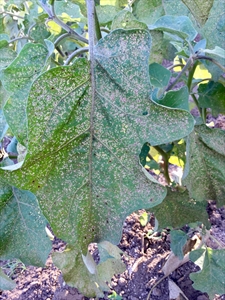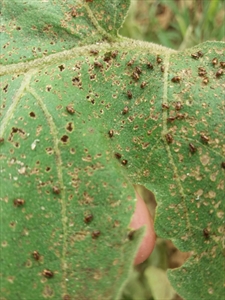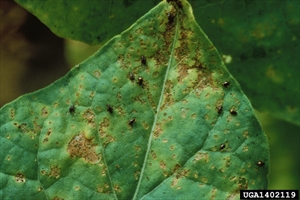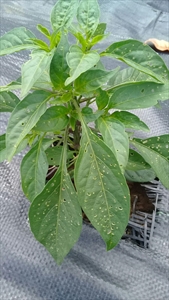Tobacco flea beetle
Pacific Pests, Pathogens and Weeds - Online edition
Pacific Pests, Pathogens & Weeds
Tobacco flea beetle (355)
Epitrix hirtipennis
North, South (Guyana) and Central America, the Caribbean, Europe, Oceania. It is recorded from Fiji and Guam.
Eggplant, and many others in the Solanaceae or nightshade family (capsicum, chilli, potato, tobacco, and tomato). Also, weeds, in the same family, e.g., Physalis angulata.
Both the larvae and adults (Photos 1&2) damage plants: the adults feed on both sides of the leaves, chewing small, irregularly-shaped, holes in the leaves resulting in a 'shot hole' appearance (Photos 3-6&8-10). Usually, seedlings are most damaged. The larvae feed on roots.
Eggs are laid at the base of the stem of hosts. The larvae are slender, white with a brownish head, less than 5 mm long. They remain underground feeding on the small roots and root hairs.
Adults are hard-shelled, brown with black markings, about 1.5-2 mm long, with long, 12-segmented antennae. Wing covers have rows of fine but distinct punctures. The hind legs of adults are relatively large, and they jump like fleas.
Large populations can kill or stunt seedlings, but economic damage of mature plants is rare for this species and other Epitrix flea beetles. Large numbers are more frequent (in Fiji at least) during periods of prolonged drought (Photo 7).
Although species of Epitrix flea beetles have been reported to feed on potato tubers, making tunnels in the flesh, in the US and Portugal, no damage of economic significance has been reported for Epitrix hirtipennis. However, analysis of the damage caused in Fiji, especially in times of drought may change this.
Look for the pits and tiny holes, many less than 1 mm, in leaves of seedlings and mature plants. Look for beetles, shiny brown and black in large numbers, especially during droughts.
CULTURAL METHODS
Before planting:
- Remove weeds, especially those in the Solanaceae (potato or nightshade) family.
- Do not plant new crops next to those infested by the flea beetle.
- If seedlings are damaged in the field, use transplants produced in a nursery.
- Use mulches; these may interfere with activity of the stages in the soil.
During growth:
- Continue to remove weeds.
- Check for flea beetles twice weekly, especially after planting the transplants.
- Use protective covers over seedlings (e.g., floating row covers, or synthetic materials supported by hoops).
After harvest:
- Collect crop debris and burn or bury it.
- Do not plant consecutive susceptible crops; rotate with maize, brassicas or legumes of at least 2 years.
CHEMICAL CONTROL
If pesticides are necessary, use botanical (plant-derived pesticides) sprays first, as these may cause less harm to natural enemies, and cost less than synthetic commercial products.
- Use neem, derris, pyrethrum or chilli. If these are used, add soap to improve wetting the flea hoppers and covering them with sprays.
- Alternatively, use commercial biopesticides, e.g., spinosad (the product is called Success), or abamectin, derived from different bacteria. Spinosad has been tested against the eggplant flea beetle, Epithix fuscula in the US and found effective.
- On tobacco, several foliar insecticides have been recommended for the control of flea beetles. These have included synthetic pyrethroids (e.g. bifenthrin, cypermethrin, deltamethrin), carbamates, and neonicotinoids. On potato, in Europe, the neonicotinoid, acetamiprid, is used against a flea beetle damaging potato tubers (renewed until 2033).
____________________
When using a pesticide (or biopesticide), always wear protective clothing and follow the instructions on the product label, such as dosage, timing of application, and pre-harvest interval. Recommendations will vary with the crop and system of cultivation. Expert advice on the most appropriate pesticide to use should always be sought from local agricultural authorities.
AUTHOR Grahame Jackson & Mani Mua
Information from Peppers. Flea beetles. UC IPM. (http://ipm.ucanr.edu/PMG/r604300611.html); and Cuthbertson AGS (2015) Chemical and ecological control methods for Epitrix spp. Global J. Environ. Sci. Manage. 1(1): 95-97 (http://www.gjesm.net/pdf_9553_82f0576dbd1b7d6b6eb59eed9b003d41.html); and from Flea beetles. Colorado State University Extension. (http://extension.colostate.edu/topic-areas/insects/flea-beetles-5-592/). Photos 1&2 Natasha Wright, Cook's Pest Control, Bugwood.org. Photos 3-6 Mani Mua, SPC, Sigatoka Research Station, Fiji. Photo 8 R.J. Reynolds, Tobacco Company Slide Set, R.J. Reynolds Tobacco Company, Bugwood2.org
Produced with support from the Australian Centre for International Agricultural Research under project HORT/2016/185: Responding to emerging pest and disease threats to horticulture in the Pacific islands, implemented by the University of Queensland and the Secretariat of the Pacific Community.













